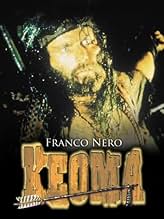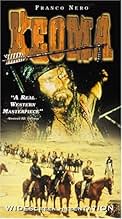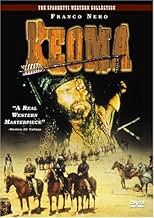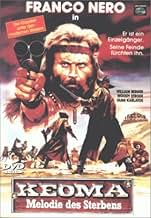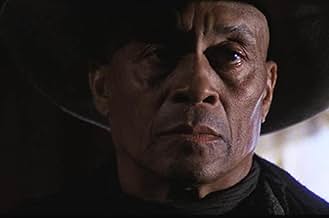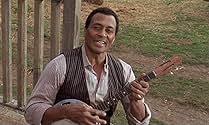IMDb-BEWERTUNG
7,0/10
6548
IHRE BEWERTUNG
Ein ehemaliger Revolverheld versucht, seine von der Pest heimgesuchte Heimatstadt vor der Übermacht seiner rassistischen Halbbrüder und eines konföderierten Tyrannen zu schützen.Ein ehemaliger Revolverheld versucht, seine von der Pest heimgesuchte Heimatstadt vor der Übermacht seiner rassistischen Halbbrüder und eines konföderierten Tyrannen zu schützen.Ein ehemaliger Revolverheld versucht, seine von der Pest heimgesuchte Heimatstadt vor der Übermacht seiner rassistischen Halbbrüder und eines konföderierten Tyrannen zu schützen.
Joshua Sinclair
- Sam Shannon
- (as John Loffredo)
Donald O'Brien
- Caldwell
- (as Donald O'Brian)
Leonardo Scavino
- Doctor
- (as Leon Lenoir)
Antonio Basile
- Caldwell's Henchman
- (Nicht genannt)
Giovanni Bonadonna
- Caldwell's Henchman
- (Nicht genannt)
Armando Bottin
- Caldwell's Henchman
- (Nicht genannt)
Aldo Canti
- Wagon Fugitive
- (Nicht genannt)
- …
Felice Ceciarelli
- Caldwell's Henchman
- (Nicht genannt)
Empfohlene Bewertungen
Though to be clear I wouldn't go as far as to call it "the best". Something the people involved are quick to point out or to. This is really good and you have a very charismatic (and hairy chested) Franco Nero starring. You also have supernatural elements, that may not be fully explained (not even by all the extras on the disc).
And you have old school shooutous, where bad guys seem to only need one bullet to bite the dust (literally), whereas good people have to be shot quite a few times mostly. So yes there are things that may seem or feel dated, but the overall sense is quite great. Not to mention the performances. Really telling and really inspired overall.
And you have old school shooutous, where bad guys seem to only need one bullet to bite the dust (literally), whereas good people have to be shot quite a few times mostly. So yes there are things that may seem or feel dated, but the overall sense is quite great. Not to mention the performances. Really telling and really inspired overall.
Talk to most Spaghetti Western fans and they will declare Keoma to be one of the finest of the genre's movies, and probably the best of the latter day ones. However they will also most probably comment on the atrocious soundtrack, which does take some getting used to. I honestly believe that if this movie had been given the Morricone touch, it would be firmly cemented as a true Spaghetti classic, standing side by side with The Big Gundown, Face to Face and Bullet for the General.
Aside from Django, this is Franco Nero's best role. A half breed venger, riding into a town decimated by both the plague and a gang of racist ex-Confederates, which includes his three hateful "brothers" in their ranks. There are also fine turns by William Berger as Keoma's adopted father Shannon, and Woody Strode as Keoma's childhood hero turned drunk, George.
As always, Castellari has injected true class into this film, with slow motion shootouts, effective flashbacks and clever camera tricks. This film is a true fitting end to the Spaghetti hay day, which had begun to loose its charm due to the ever increasing stupidity of the comedy westerns. The only negative aspect is that wretched soundtrack. Oh where was Morricone when we really needed him?
Aside from Django, this is Franco Nero's best role. A half breed venger, riding into a town decimated by both the plague and a gang of racist ex-Confederates, which includes his three hateful "brothers" in their ranks. There are also fine turns by William Berger as Keoma's adopted father Shannon, and Woody Strode as Keoma's childhood hero turned drunk, George.
As always, Castellari has injected true class into this film, with slow motion shootouts, effective flashbacks and clever camera tricks. This film is a true fitting end to the Spaghetti hay day, which had begun to loose its charm due to the ever increasing stupidity of the comedy westerns. The only negative aspect is that wretched soundtrack. Oh where was Morricone when we really needed him?
Director Castellari is nowadays perhaps best-known (if at all) by the younger generation of film buffs for one thing: making the original INGLORIOUS BASTARDS (1977), which Quentin Tarantino has been threatening to remake for years now. However, in my opinion, he should instead be remembered for making this impressive, belated Spaghetti Western gem.
An odd blend of violent action and heady mysticism apparently concocted by one of the credited screenwriters Luigi Montefiori (better known to hardened Euro-Cult fans as an actor under the alias of George Eastman) but, as star Franco Nero and Castellari himself state in the Anchor Bay DVD supplements, the script took so long to get written that they decided to work without one and make the dialogue up as they went along! That the end result is so satisfying (and practically unique in the subgenre) is a remarkable achievement in itself.
Keoma is a half-breed returning home from the American Civil War to find his hometown ravaged by the plague and overtaken by the villainous Caldwell (Donal O' Brien); among his cohorts are Nero's three half-brothers who had made his childhood a living hell, with his surrogate father (William Berger) and colored mentor turned banjo-playing town-drunk (Woody Strode) unable to do much to counter Caldwell's oppression. A Bergmanesque, cadaverous old woman is frequently seen roaming the streets dragging a cart behind her...
What follows is the typical confrontation between Good and Evil but Castellari infuses the familiar mixture with several directorial flourishes: occasionally striking compositions (particularly a memorably Fordian opening shot), frequent use of slow-motion in true Peckinpah-style, flashbacks in which Keoma is a spectator to his own past experiences (inspired by Elia Kazan's THE ARRANGEMENT [1969]!), a touch of elliptical editing, Christian symbolism (Keoma is crucified at one point) and, most distressingly of all, a folksy soundtrack (inspired by Leonard Cohen and Bob Dylan, no less and warbled...er...sung by a shrill, high-pitched female singer and an out-of-tune deep-voiced male) which narrates in song the action we're seeing on the screen. I say distressingly because the Guido and Maurizo De Angelis compositions found here have forever been a thorn in the side of even the film's staunchest admirers!! Personally, I didn't mind the female singer so much after a while but when her (possibly drunk) male companion took over in the last half hour, I was in for some cringe-inducing moments for sure...!
Despite these misgivings, the film is still one of the best Spaghetti Westerns out there (and certainly the last great example of the subgenre); its undoubted highlight is provided by a terrific, lovingly protracted action set-piece in which Nero, Berger and a reformed Strode (back to his former arrow-shooting glory - perhaps a nod to the role he played in Richard Brooks' splendid THE PROFESSIONALS [1966]) wipe out most of Caldwell's gang. Their triumph is short-lived, however, because both Berger and Strode lose their lives in the ongoing struggle (Berger poignantly so, while Strode's death scene is particularly great), with Nero almost bowing out himself under the strain of his siblings' torture - who have subsequently disposed of Caldwell and taken over the town themselves; the final confrontation, then, between Keoma and his three half-brothers is eerily set to the "strains" of Olga Karlatos' (playing a woman Keoma had earlier on saved from a plague-infested colony) wailing and screaming as she lies giving birth to a child amidst the carnage!
While at first I was disappointed that the Anchor Bay DVD only included the English dub, having watched it now it seems clear that the actors were all speaking their dialogue in English on the set - although, as connoisseurs will certainly know, this was all re-recorded back in the studios anyway (as was common practice in the Italian film industry). Still, if ever it gets shown again on Italian TV, I'll be sure to check it out just for completeness' sake. Thankfully, however, Castellari contributes a highly enthusiastic and informative Audio Commentary in which he discusses his major influences while making the film, among them Sidney J. Furie's THE APPALOOSA (1966), Altman's McCABE AND MRS. MILLER (1971) and Peckinpah's PAT GARRETT AND BILLY THE KID (1973).
Ultimately, Franco Nero in the title role is almost as iconic a figure as Django and, hopefully, I should be getting to another fairly obscure but highly intriguing Spaghetti Westen of his - Luigi Bazzoni's MAN, PRIDE AND VENGEANCE (1968), an eccentric updating of Georges Bizet's opera "Carmen", co-starring Klaus Kinski and Tina Aumont - pretty soon...
An odd blend of violent action and heady mysticism apparently concocted by one of the credited screenwriters Luigi Montefiori (better known to hardened Euro-Cult fans as an actor under the alias of George Eastman) but, as star Franco Nero and Castellari himself state in the Anchor Bay DVD supplements, the script took so long to get written that they decided to work without one and make the dialogue up as they went along! That the end result is so satisfying (and practically unique in the subgenre) is a remarkable achievement in itself.
Keoma is a half-breed returning home from the American Civil War to find his hometown ravaged by the plague and overtaken by the villainous Caldwell (Donal O' Brien); among his cohorts are Nero's three half-brothers who had made his childhood a living hell, with his surrogate father (William Berger) and colored mentor turned banjo-playing town-drunk (Woody Strode) unable to do much to counter Caldwell's oppression. A Bergmanesque, cadaverous old woman is frequently seen roaming the streets dragging a cart behind her...
What follows is the typical confrontation between Good and Evil but Castellari infuses the familiar mixture with several directorial flourishes: occasionally striking compositions (particularly a memorably Fordian opening shot), frequent use of slow-motion in true Peckinpah-style, flashbacks in which Keoma is a spectator to his own past experiences (inspired by Elia Kazan's THE ARRANGEMENT [1969]!), a touch of elliptical editing, Christian symbolism (Keoma is crucified at one point) and, most distressingly of all, a folksy soundtrack (inspired by Leonard Cohen and Bob Dylan, no less and warbled...er...sung by a shrill, high-pitched female singer and an out-of-tune deep-voiced male) which narrates in song the action we're seeing on the screen. I say distressingly because the Guido and Maurizo De Angelis compositions found here have forever been a thorn in the side of even the film's staunchest admirers!! Personally, I didn't mind the female singer so much after a while but when her (possibly drunk) male companion took over in the last half hour, I was in for some cringe-inducing moments for sure...!
Despite these misgivings, the film is still one of the best Spaghetti Westerns out there (and certainly the last great example of the subgenre); its undoubted highlight is provided by a terrific, lovingly protracted action set-piece in which Nero, Berger and a reformed Strode (back to his former arrow-shooting glory - perhaps a nod to the role he played in Richard Brooks' splendid THE PROFESSIONALS [1966]) wipe out most of Caldwell's gang. Their triumph is short-lived, however, because both Berger and Strode lose their lives in the ongoing struggle (Berger poignantly so, while Strode's death scene is particularly great), with Nero almost bowing out himself under the strain of his siblings' torture - who have subsequently disposed of Caldwell and taken over the town themselves; the final confrontation, then, between Keoma and his three half-brothers is eerily set to the "strains" of Olga Karlatos' (playing a woman Keoma had earlier on saved from a plague-infested colony) wailing and screaming as she lies giving birth to a child amidst the carnage!
While at first I was disappointed that the Anchor Bay DVD only included the English dub, having watched it now it seems clear that the actors were all speaking their dialogue in English on the set - although, as connoisseurs will certainly know, this was all re-recorded back in the studios anyway (as was common practice in the Italian film industry). Still, if ever it gets shown again on Italian TV, I'll be sure to check it out just for completeness' sake. Thankfully, however, Castellari contributes a highly enthusiastic and informative Audio Commentary in which he discusses his major influences while making the film, among them Sidney J. Furie's THE APPALOOSA (1966), Altman's McCABE AND MRS. MILLER (1971) and Peckinpah's PAT GARRETT AND BILLY THE KID (1973).
Ultimately, Franco Nero in the title role is almost as iconic a figure as Django and, hopefully, I should be getting to another fairly obscure but highly intriguing Spaghetti Westen of his - Luigi Bazzoni's MAN, PRIDE AND VENGEANCE (1968), an eccentric updating of Georges Bizet's opera "Carmen", co-starring Klaus Kinski and Tina Aumont - pretty soon...
After the American Civil War, the half-breed Keoma (Franco Nero) returns to his homeland and rescues a beautiful pregnant woman accused of having plague, Lisa (Olga Karlatos), from a gang leaded by the landlord Caldwell (Donald O'Brian). Later he meets his former slave servant and friend George (Woody Strode), now a drunk free man, and his father, William Shannon (William Berger), and he is informed that the town is under siege of Caldwell's men, without supplies of medicine or food and justice, with the dweller dying of plague and starvation and sick people is being isolated in an old mine. Further, his three dangerous half-brothers have joined Caldwell's force. Keoma decides to help Lisa and the dwellers to retrieve their freedom and dignity, and he finds how despicable the inhabitants are.
The unknown western "Keoma" was a great surprise for me. Although predictable, the story is great, disclosing the relationship of Keoma with his brothers and father through his recollections from his childhood, and does not have a happy commercial end. Franco Nero is amazing in the role of a lonely half-Indian with a great sense of justice and freedom, love and loyalty to his father and regret and resentment to his half-brothers. The direction and cinematography are excellent, with a fantastic choreography of the fights, set decoration and costumes: in the dusty, windy and dirty city, the men's clothes (and themselves) are very dirty, and not like in most of Hollywood movies, where the cowboys wear very clean clothes. There is a particular scene that I believe is unique in the cinema, when Keoma promises four bullets for four hit men, and while bending his four fingers, we see each of his targets. The annoying soundtrack, although having the good intention of creating a narrative of the feelings of the characters, is the only negative aspect in this movie. My vote is seven.
Title (Brazil): "Keoma"
The unknown western "Keoma" was a great surprise for me. Although predictable, the story is great, disclosing the relationship of Keoma with his brothers and father through his recollections from his childhood, and does not have a happy commercial end. Franco Nero is amazing in the role of a lonely half-Indian with a great sense of justice and freedom, love and loyalty to his father and regret and resentment to his half-brothers. The direction and cinematography are excellent, with a fantastic choreography of the fights, set decoration and costumes: in the dusty, windy and dirty city, the men's clothes (and themselves) are very dirty, and not like in most of Hollywood movies, where the cowboys wear very clean clothes. There is a particular scene that I believe is unique in the cinema, when Keoma promises four bullets for four hit men, and while bending his four fingers, we see each of his targets. The annoying soundtrack, although having the good intention of creating a narrative of the feelings of the characters, is the only negative aspect in this movie. My vote is seven.
Title (Brazil): "Keoma"
A half-breed Indian Keoma returns back to his hometown after fighting in the Civil War, and finds his town is being run by an ex-Confederate soldier Caldwell and his outlaws. He holds power over the town by letting the plague infect the inhabitants, and since he won't let any sort of treatment be transported in. He sets up a community for those infected, and this where Keoma rescues a pregnant woman on her way there and returns her back to town. His three half-brothers have joined Caldwell, and I don't think that highly of their brother's return. But loyalty to their father, they won't kill him. His father William Shannon and former family servant/only friend George eventually join Keoma to break the strangle hold Caldwell possess.
Whoa! How good? Real good. Director Enzo G. Castellari's grand looking and interesting spaghetti western comes across as a powerful and beautifully constructed Greek tragedy with a cynical and almost psychological edge bound to it. There's a bit everything chucked into this passionate and intelligent exercise. Breathing high on mood and atmosphere, photographer Aiace Parolin exquisitely frames the mercilessly brooding locations and Castellari's stylishly first-rate direction keeps the film sombre with a brutally unsparing and dirt-laced tone in its dramatic images and context. Good use of abstract lighting and composition, he knows how to keep the viewer at bay with slam-bang set pieces towards the end and a downbeat undercurrent. Inventive framing and exposition also shows the quality of his direction. The glorious slow-motion shootouts and editing technique (ala Sam Peckinpah) are dazzling and how about the constant jumping or leaping in the air. Was there a hidden trampoline on set?! Everything about it held a nice rhythm to it and you just get swept along. Even the flashback sequences are positioned in the story accordingly and in a fulfilling style. The lyrical story is full of symbolic and thematic issues (freedom being the main focal point) that do pack a punch, but also showing a vulnerable side. This gave it a real singular vibe to set it apart from the crowd. Hell, I didn't mind the uncanny and soaring ballad soundtrack too. The way it actually interlocked with the film's sequences, I thought it gave the film some soul and a backbone (well other than always charismatically reliable Nero). A rugged Franco Nero was outstanding. Both mentally and psychically in his scrappy determination and seldom figure Keoma. The impressively committed Woody Strode was excellent. William Berger brought class, and Olga Karlatos decently balanced out an innocent side that really was moving. Donald O'Brien nails it down in a starch turn as the villainous Caldwell.
Whoa! How good? Real good. Director Enzo G. Castellari's grand looking and interesting spaghetti western comes across as a powerful and beautifully constructed Greek tragedy with a cynical and almost psychological edge bound to it. There's a bit everything chucked into this passionate and intelligent exercise. Breathing high on mood and atmosphere, photographer Aiace Parolin exquisitely frames the mercilessly brooding locations and Castellari's stylishly first-rate direction keeps the film sombre with a brutally unsparing and dirt-laced tone in its dramatic images and context. Good use of abstract lighting and composition, he knows how to keep the viewer at bay with slam-bang set pieces towards the end and a downbeat undercurrent. Inventive framing and exposition also shows the quality of his direction. The glorious slow-motion shootouts and editing technique (ala Sam Peckinpah) are dazzling and how about the constant jumping or leaping in the air. Was there a hidden trampoline on set?! Everything about it held a nice rhythm to it and you just get swept along. Even the flashback sequences are positioned in the story accordingly and in a fulfilling style. The lyrical story is full of symbolic and thematic issues (freedom being the main focal point) that do pack a punch, but also showing a vulnerable side. This gave it a real singular vibe to set it apart from the crowd. Hell, I didn't mind the uncanny and soaring ballad soundtrack too. The way it actually interlocked with the film's sequences, I thought it gave the film some soul and a backbone (well other than always charismatically reliable Nero). A rugged Franco Nero was outstanding. Both mentally and psychically in his scrappy determination and seldom figure Keoma. The impressively committed Woody Strode was excellent. William Berger brought class, and Olga Karlatos decently balanced out an innocent side that really was moving. Donald O'Brien nails it down in a starch turn as the villainous Caldwell.
Wusstest du schon
- WissenswertesThe story line of the film was mostly improvised at the same time as the film was made. The original story treatment was written by Luigi Montefiori (aka George Eastman) and turned into a script by Mino Roli and Nico Ducci, but director Enzo G. Castellari didn't like what had been written by the latter two. Because of problems with the schedule, Castellari and actor Joshua Sinclair wrote the script for the next day every evening after filming of the day. Castellari was also open to suggestions from the cast and crew - Franco Nero has confirmed that he wrote some of his own dialogue.
- PatzerAt 7:08 riders on horseback in pursuit of two men running on foot fire their pistols. Both men on foot react as if hit by the first shot.
- Alternative VersionenGerman version was cut for violence and pacing reasons by 8 minutes to secure a "not under 16" rating. Despite that, it still got put on the index list by the BPjM which means various sales and advertising restrictions. Fortunately in 2003, the movie was removed from the index list and the FSK granted the uncut version a "not under 16" rating.
- VerbindungenFeatured in L'oeil du cyclone: Westernissimo (1995)
- SoundtracksKeoma
(uncredited)
Music by Guido De Angelis & Maurizio De Angelis
Lyrics by Susan Duncan Smith and Cesare De Natale
Performed by Sibyl Mostert and Cesare De Natale
Top-Auswahl
Melde dich zum Bewerten an und greife auf die Watchlist für personalisierte Empfehlungen zu.
- How long is Keoma?Powered by Alexa
Details
Zu dieser Seite beitragen
Bearbeitung vorschlagen oder fehlenden Inhalt hinzufügen

Oberste Lücke
By what name was Keoma - Melodie des Sterbens (1976) officially released in India in English?
Antwort

